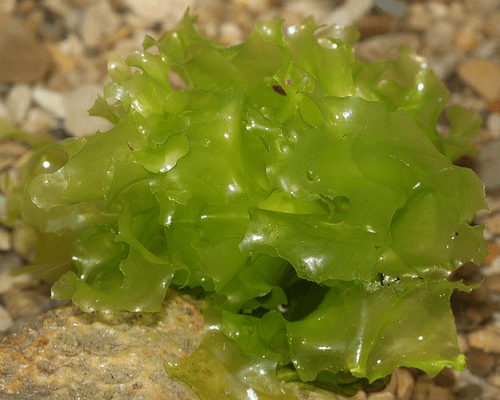
The thriving industry of seaweed cultivation, a sustainability and food production model based on oceans, faces a critical challenge: early detection of stress in cultivated seaweed.
So far, monitoring the health of seaweed has relied on laborious methods. But what if a small molecule, naturally produced by the seaweed itself, could be the key to ushering in a new era of seaweed health diagnostics?
Like in other aquaculture sectors, seaweed mariculturists must establish indicators to assess the “health” of their crops. Thus, a team of scientists from the Woods Hole Oceanographic Institution, the Massachusetts Institute of Technology, and the University of Gothenburg studied the behavior of hydrogen peroxide in the cultivation of Palmaria palmata and Ulva fenestrata seaweeds.
Stress factors in macroalgae farms
Like any living organism, seaweed farms are vulnerable to various threats. Environmental stressors such as temperature changes, salinity, and disease outbreaks can wreak havoc and lead to significant crop losses.
Current methods for monitoring and controlling the health of seaweed are often labor-intensive and unreliable. Visual inspection for disease detection or relying on biomass changes are reactive approaches that leave little room for proactive intervention.
Hydrogen Peroxide (H2O2)
H2O2, a reactive oxygen species (ROS), plays a dual role: a stress signal when things go wrong and a contributor to the formation of important gases influencing climate. H2O2, a natural byproduct of plant metabolism, plays a crucial role in both defense and stress response.
Recent research has focused on its remarkable stability and ease of measurement in seawater, making it a promising health indicator for seaweed crops.
When seaweed encounters a threat, its production of H2O2 accelerates, creating a revealing stress bubble in the surrounding water. This increase in H2O2 could be the key to proactive intervention in seaweed crops.
Behavior of H2O2
The research team conducted studies with individuals of Palmaria palmata and Ulva fenestrata, extracted from aerated indoor cultures at the Tjärnö Marine Laboratory.
The study delves into and records the behavior of H2O2 throughout the day in seaweed. From subtle changes in light and temperature to sudden stress shocks, scientists meticulously tracked its fluctuations. Their findings paint a fascinating picture:
- Daily rhythm: H2O2 levels naturally decrease and flow with the sun, rising slightly during the day and descending at night.
- Stress factors: When seaweed faces acute stress factors, such as sudden temperature spikes, H2O2 increases dramatically, reaching levels many times higher than observed during the day-night cycle.
The rapid and sharp increase in H2O2 serves as an intermittent red alert, revealing the struggle of seaweed under stress. This early warning system has immense potential to revolutionize seaweed aquaculture:
- Proactive interventions: By monitoring H2O2 levels, mariculturists can detect stress before visible symptoms appear, allowing them to take swift action to adjust parameters and optimize conditions.
- Better crop health: Early stress detection translates to faster intervention and better management, leading to healthier and more resilient seaweed crops.
- Sustainable practices: H2O2 monitoring offers a cost-effective and non-invasive way to optimize farm conditions, promoting sustainable and responsible seaweed production.
Impact on the seaweed cultivation industry
According to the scientists, “The findings provide evidence that H2O2 monitoring could be used as a health indicator in seaweed aquaculture and serve as an early stress warning signal.”
The study results pave the way for the development of sensors that constantly monitor H2O2 levels around seaweed and send real-time alerts whenever stress levels increase. This way, seaweed mariculturists could then take specific actions, adjust conditions, or implement mitigation strategies before significant damage occurs.
Conclusion
“Our results reveal that exposure to acute stress factors leads to rapid and sustained concentrations of H2O2 that are orders of magnitude higher than changes in H2O2 concentrations observed throughout the day,” the scientists concluded.
Ultimately, harnessing the power of H2O2 monitoring can revolutionize seaweed aquaculture. By turning small bubbles into powerful stress indicators, we can ensure the sustainable growth of this vital industry, contributing to food security, ocean health, and a better future for our planet.
Contact
Colleen M. Hansel
Department of Marine Chemistry and Geochemistry, Woods Hole Oceanographic Institution
Woods Hole, MA, 02543, USA
Email: chansel@whoi.edu
Reference (open access)
Taenzer, L., Toth, G. & Hansel, C.M. Assessment of hydrogen peroxide as a bioindicator of stress in seaweed aquaculture. Sci Rep 14, 1956 (2024). https://doi.org/10.1038/s41598-024-52182-5
Editor at the digital magazine AquaHoy. He holds a degree in Aquaculture Biology from the National University of Santa (UNS) and a Master’s degree in Science and Innovation Management from the Polytechnic University of Valencia, with postgraduate diplomas in Business Innovation and Innovation Management. He possesses extensive experience in the aquaculture and fisheries sector, having led the Fisheries Innovation Unit of the National Program for Innovation in Fisheries and Aquaculture (PNIPA). He has served as a senior consultant in technology watch, an innovation project formulator and advisor, and a lecturer at UNS. He is a member of the Peruvian College of Biologists and was recognized by the World Aquaculture Society (WAS) in 2016 for his contribution to aquaculture.
